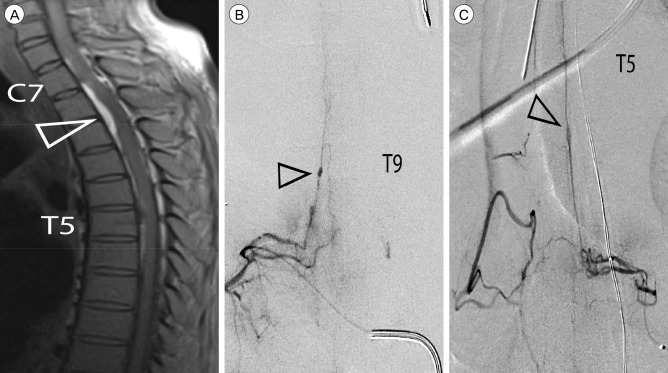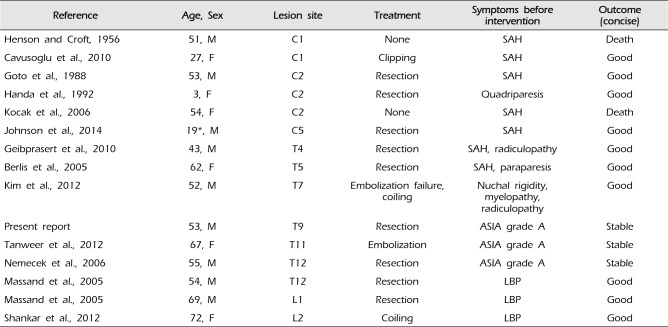1. Berlis A, Scheufler KM, Schmahl C, Rauer S, Götz F, Schumacher M. Solitary spinal artery aneurysms as a rare source of spinal subarachnoid hemorrhage: potential etiology and treatment strategy. AJNR Am J Neuroradiol. 2005; 2. 26(2):405–410. PMID:
15709145.
2. Biondi A, Merland JJ, Hodes JE, Aymard A, Reizine D. Aneurysms of spinal arteries associated with intramedullary arteriovenous malformations. II. Results of AVM endovascular treatment and hemodynamic considerations. AJNR Am J Neuroradiol. 1992; May-Jun. 13(3):923–931. PMID:
1590192.
3. Cavusoglu H, Ozdilmac A, Sahin Y, Aydin Y. Isolated posterior spinal artery aneurysm causing intracranial acute subarachnoidal hemorrhage. Acta Neurochir (Wien). 2010; 4. 152(4):721–724. PMID:
19693431.
4. Doppman JL, Di Chiro G, Glancy DL. Collateral circulation through dilated spinal cord arteries in aortic coarctation and extraspinal arteriovenous shunts. An arteriographic study. Clin Radiol. 1969; 4. 20(2):192–197. PMID:
5781764.

5. Fody EP, Netsky MG, Mrak RE. Subarachnoid spinal hemorrhage in a case of systemic lupus erythematosus. Arch Neurol. 1980; 3. 37(3):173–174. PMID:
7356425.

6. Geibprasert S, Krings T, Apitzsch J, Reinges MH, Nolte KW, Hans FJ. Subarachnoid hemorrhage following posterior spinal artery aneurysm. A case report and review of the literature. Interv Neuroradiol. 2010; 6. 16(2):183–190. PMID:
20642894.
7. Goto Y, Kamijyo Y, Yonekawa Y, Kikuchi H. Ruptured aneurysm of the posterior spinal artery of the upper cervical spinal cord: case report. Neurosurgery. 1988; 3. 22(3):558–560. PMID:
3362323.

8. Handa T, Suzuki Y, Saito K, Sugita K, Patel SJ. Isolated intramedullary spinal artery aneurysm presenting with quadriplegia. Case report. J Neurosurg. 1992; 7. 77(1):148–150. PMID:
1607957.
9. Henson RA, Croft PB. Spontaneous spinal subarachnoid haemorrhage. Q J Med. 1956; 1. 25(97):53–66. PMID:
13323242.
10. Johnson J, Patel S, Saraf-Lavi E, Aziz-Sultan MA, Yavagal DR. Posterior spinal artery aneurysm rupture after 'Ecstasy' abuse. J Neurointerv Surg. 2015; 7. 7(7):e23. PMID:
25006043.

11. Kim HJ, Choi IS. Dissecting aneurysm of the posterior spinal artery: case report and review of the literature. Neurosurgery. 2012; 9. 71(3):E749–E756. discussion E756PMID:
22592330.
12. Kocak A, Ates O, Cayli SR, Sarac K. Isolated posterior spinal artery aneurysm. Br J Neurosurg. 2006; 8. 20(4):241–244. PMID:
16954077.
13. Kossorotoff M, Touze E, Godon-Hardy S, Serre I, Mateus C, Mas JL, et al. Cerebral vasculopathy with aneurysm formation in HIV-infected young adults. Neurology. 2006; 4. 66(7):1121–1122. PMID:
16606935.

14. Massand MG, Wallace RC, Gonzalez LF, Zabramski JM, Spetzler RF. Subarachnoid hemorrhage due to isolated spinal artery aneurysm in four patients. AJNR Am J Neuroradiol. 2005; 10. 26(9):2415–2419. PMID:
16219857.
15. Nemecek AN, Sviri G, Hevner R, Ghodke B, Britz GW. Dissecting aneurysm of the thoracic posterior spinal artery. Case illustration. J Neurosurg Spine. 2006; 12. 5(6):555. PMID:
17176024.
16. Shankar JJ, terBrugge K, Krings T. Subarachnoid hemorrhage following posterior spinal artery aneurysm rupture. Can J Neurol Sci. 2012; 7. 39(4):531–532. PMID:
22728865.

17. Takahashi JC, Sakai N, Iihara K, Sakai H, Higashi T, Kogure S, et al. Subarachnoid hemorrhage from a ruptured anterior cerebral artery aneurysm caused by polyarteritis nodosa. Case report. J Neurosurg. 2002; 1. 96(1):132–134. PMID:
11794594.
18. Tanweer O, Woldenberg R, Zwany S, Setton A. Endovascular obliteration of a ruptured posterior spinal artery pseudoaneurysm. J Neurosurg Spine. 2012; 10. 17(4):334–336. PMID:
22881040.

19. Weir B. Unruptured intracranial aneurysms: a review. J Neurosurg. 2002; 1. 96(1):3–42. PMID:
11794601.

20. Yoong MF, Blumbergs PC, North JB. Primary (granulomatous) angiitis of the central nervous system with multiple aneurysms of spinal arteries. Case report. J Neurosurg. 1993; 10. 79(4):603–607. PMID:
8410233.








 PDF
PDF ePub
ePub Citation
Citation Print
Print



 XML Download
XML Download